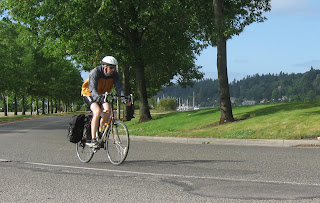Last year, I wrote two posts about getting started commuting by bicycle. The first post looked at it purely from the equipment end of things -- your bike and accessories. The second post looked at the issue more in terms of logistics and practicality. Since then, I've not re-visited the topic of bicycle commuting. With spring around the corner, gas prices creeping past the $3 per gallon mark in Seattle, and the bicycle commuter challenge in Seattle coming up in just a couple of months, it is high time I did.
This post will move from the major planning considerations into actually riding that commute.
First, a note about safety. Reading blogs and news stories (and their comments) online, one common theme is that people feel unsafe riding in traffic. It is true that we mix it up out there with masses of steel weighing many times more than we do on our bikes, but that does not mean it is unsafe. Safe, predictable riding behavior, as well as intelligent route selection helps to reduce the risk a cyclist faces when riding amongst motorists. In 2007, the most recent year in which I could find data, there were 7 cyclist fatalities (reference) in Washington state, as opposed to 567 general traffic deaths, which includes both those in car as well as those not traveling in cars (reference).
Get educated. Find a group that will teach you the ins and outs of riding in traffic. Learn how traffic laws apply to cyclists (take a good deal of time on this, few people, police included, really know this stuff). In Seattle, for instance, the Cascade Bicycle Club offers commuting classes during leading up to and during bike month as a way to help people make the shift to bike commuting. Also in Seattle, Spokespeople meets once a month for a leisurely ride on routes linking various neighborhoods in the city. The goal of these rides is to help riders learn how to move through our streets safely and in a way that allows you to coexist safely with motorists. Look up a local cycling club and see what they offer in the way of training or pointers. Very often clubs will have rides geared for new cyclists which will focus on riding the roads, mixed in with the car traffic.
Use smart route planning. Chances are, the route you take to get to work, whether you drive or bus, is not the best route to bike. In fact, in some places, it may be illegal.
- Look to resources that are available through your city or county transportation departments. They often provide cycling route maps.
- Use online resources such as MapMyRide or discussion forums from local bike groups to find routes that others have scouted that take you to work. Google has just added a bike layer to their popular Google Maps service. This latest addition, announced yesterday, has the bike blogging community abuzz with excitement (seriously, I've seen no less than a dozen different posts about it in my news reader since Tuesday night!).
- Look for bike paths, multi-use paths or bike lanes that take you where you need to go.
- Look for parallel side streets along your usual route that provide lower speed or traffic-calmed roadways. In many areas, just one or two blocks off of high-traffic arterial streets there are streets with lower speed limits and lower traffic counts. These streets can be much more of a joy to ride than the arterials. In fact, some communities are creating "Bike Boulevards" out of these roadways to encourage safer cycling and walking.
Now, pick an enjoyable route, dust off your bike, and take a ride. When you're ready, tackle that ride to work!




2 comments:
"In 2007, the most recent year in which I could find data, there were 7 cyclist fatalities (reference) in Washington state, as opposed to 567 general traffic deaths"
Remember, to compare these numbers without scaling to overall use is bad math. If only 6 people in Seattle play Russian Roulette but approx 5 of them die per year it would appear playing Russian Roulette is safer than riding a bike in Seattle...However, statistically, its just not true. good post otherwise!
Great post....and look, you may have gotten a cool DVD! (We've actually given similar DVD's as gifts) I will pass this along to Chris!
Post a Comment